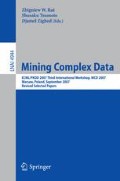Abstract
Finding temporally covariant variables is very important for clinical practice because we are able to obtain the measurements of some examinations very easily, while it takes a long time for us to measure other ones. Also, unexpected covariant patterns give us new knowledge for temporal evolution of chronic diseases. This paper focuses on clustering of trajectories of temporal sequences of two laboratory examinations. First, we map a set of time series containing different types of laboratory tests into directed trajectories representing temporal change in patients’ status. Then the trajectories for individual patients are compared in multiscale and grouped into similar cases by using clustering methods. Experimental results on the chronic hepatitis data demonstrated that the method could find the groups of trajectories which reflects temporal covariance of platelet, albumin and choline esterase.
Access this chapter
Tax calculation will be finalised at checkout
Purchases are for personal use only
Preview
Unable to display preview. Download preview PDF.
References
Ueda, N., Suzuki, S.: A Matching Algorithm of Deformed Planar Curves Using Multiscale Convex/Concave Structures. IEICE Transactions on Information and Systems J73-D-II(7), 992–1000 (1990)
Lindeberg, T.: Scale-Space for Discrete Signals. IEEE Trans. PAMI 12(3), 234–254 (1990)
Everitt, B.S., Landau, S., Leese, M.: Cluster Analysis, 4th edn. Arnold Publishers (2001)
Hirano, S., Tsumoto, S.: An Indiscernibility-Based Clustering Method with Iterative Refinement of Equivalence Relations - Rough Clustering -. Journal of Advanced Computational Intelligence and Intelligent Informatics 7(2), 169–177 (2003)
Tsumoto, S., Hirano, S., Takabayashi, K.: Development of the Active Mining System in Medicine Based on Rough Sets. Journal of Japan Society of Artificial Intelligence 20(2), 203–210 (2005)
Author information
Authors and Affiliations
Editor information
Rights and permissions
Copyright information
© 2008 Springer-Verlag Berlin Heidelberg
About this paper
Cite this paper
Hirano, S., Tsumoto, S. (2008). Trajectory Analysis of Laboratory Tests as Medical Complex Data Mining. In: Raś, Z.W., Tsumoto, S., Zighed, D. (eds) Mining Complex Data. MCD 2007. Lecture Notes in Computer Science(), vol 4944. Springer, Berlin, Heidelberg. https://doi.org/10.1007/978-3-540-68416-9_3
Download citation
DOI: https://doi.org/10.1007/978-3-540-68416-9_3
Publisher Name: Springer, Berlin, Heidelberg
Print ISBN: 978-3-540-68415-2
Online ISBN: 978-3-540-68416-9
eBook Packages: Computer ScienceComputer Science (R0)

